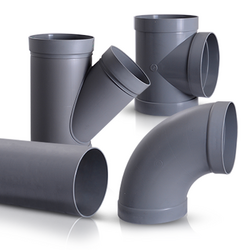
Ventilation systems made of plastics are widely used in many areas and sectors where the conventional materials, such as plated steel or stainless steel become insufficient due to their limitations. Plastics have traditionally been used in laboratories, chemical industry or spaces of high purity grade.
Our plastic ducts are intended for installation in ventilation systems for the transport of polluted air and aggressive vapours in fume cupboards, chemical plants, laboratories, swimming pool machinery rooms and have the Hygienic Certificates for ducts and fittings made of PPs and PVC. Plastic ducting is an excellent choice for heating and cooling as it offers better insulation than other materials such as metal. The smoothness of plastic ducts, which allows air to circulate freely, means that airflow is consistent and adequate.
Chemical resistant ventilation ductwork – available types and characteristics of plastics:
PVC - polyvinyl chloride: is characterized by high chemical resistance (especially to organic acids and lye), high stability and rigidity, high resistance to corrosion, operating temperature from 0 to +60˚C, as well as self-extinguishing capacity. Plastics welding or bonding up to Ø 250.
White PVC - used for outdoors.
PP - polypropylene duct: high chemical resistance (especially to solvents and alcohols), high resistance to corrosion, hot water and water vapour, operating temperature from 0 to 80˚C, normally flammable material.
Polypropylene is a durable material that withstands wear, corrosion and cracking, ensuring long-term performance even in harsh environments. This durability is essential for the continuous and reliable operation of ventilation systems.
PPs - shares the basic characteristics of polypropylene (PP), but is also flame resistant and bears high resistance to temperature - the range of operating temperature scales from 0 to 90˚C.
Due to its low flammability, PPs is often used for ventilation and exhaust ducting in industrial facilities and buildings. PPs is a low flammability polypropylene which, thanks to the addition of flame retardants, complies with building material class B1 (according to DIN 4102) and is ideal for use in air conditioning and ventilation systems. In industrial plants, flame retardant thermoplastics are used to remove air and aggressive gases, as metal materials are vulnerable due to their susceptibility to corrosion.
PP-EL-s - apart from having the same characteristics as PPs, it is also an electrically conductive material. This effect is achieved by providing PPs with specifically conductive particles.
PP-EL-s is used in potentially explosive atmospheres where static charges can occur with liquids or dusts. In order to safely discharge static electricity, the piping system must be made of a conductive material.
PE - polyethylene: high chemical resistance, high resistance to hot water and water vapour, UV resistant, operating temperature from -50 to 70˚C, normally flammable material.
It contains no toxic materials, chlorides or heavy metals, is resistant to environmental UV and gamma radiation and offers high impact resistance for durability. These are the main advantages of polyethylene that make it perfect for ducting in various ventilation systems.